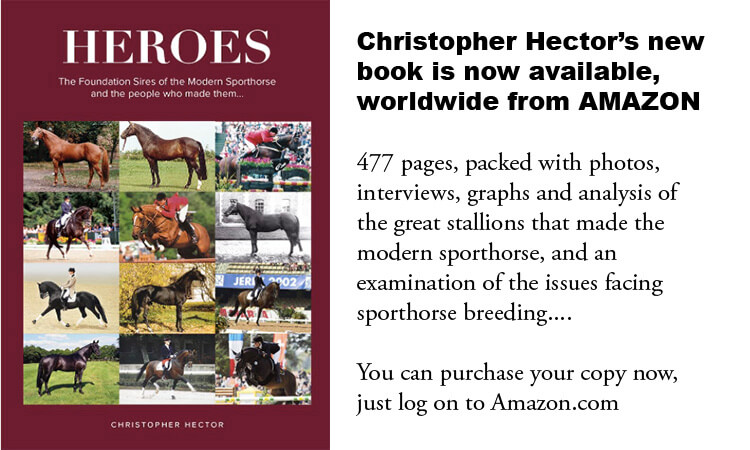Christopher Hector explores the fascinating history of one of the dressage world’s breeding powerhouses…
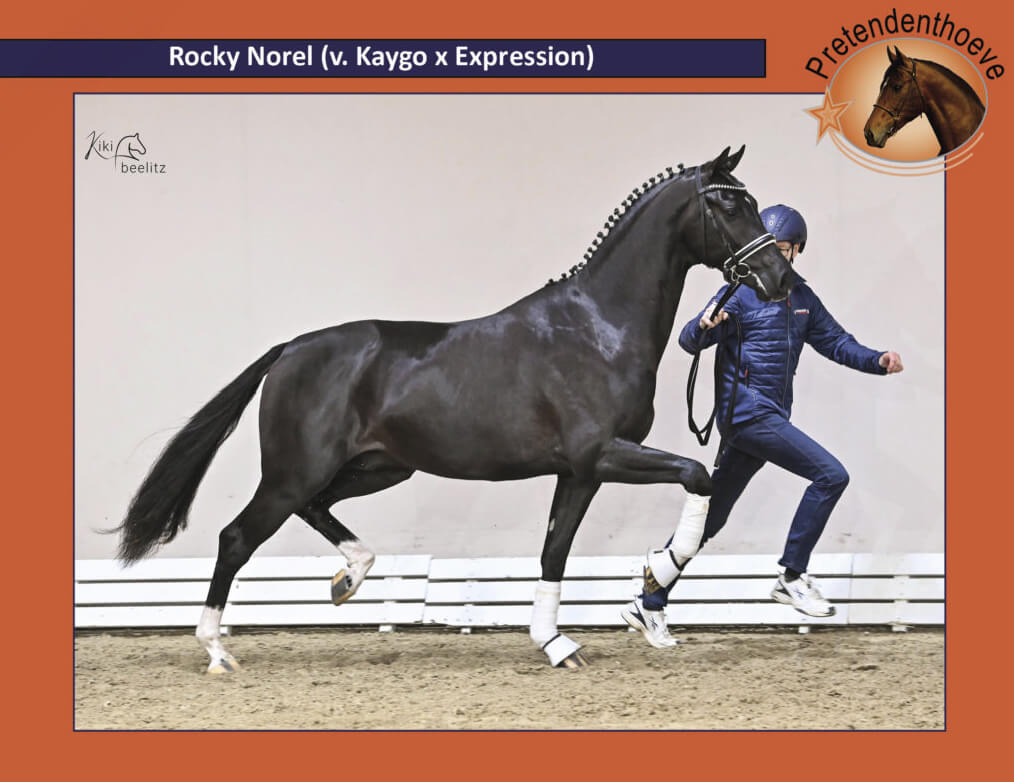
Like many registered stallions, Rocky Norel has two names, but his case is somewhat special, if you add the two together you more or less have a history of dressage breeding in The Netherlands.
The Norel suffix celebrates the first Dutch breeder to turn from jumping as the breeding goal. Gerrit Willen van Norel founded his stud in 1969 with the avowed aim of breeding for dressage. The young stallion’s original name, Rocky Zelma celebrates one of the foundation mares of van Norel’s breeding program, and also underlines the somewhat neglected role of the Gelderlander in the shaping of today’s dressage stars.
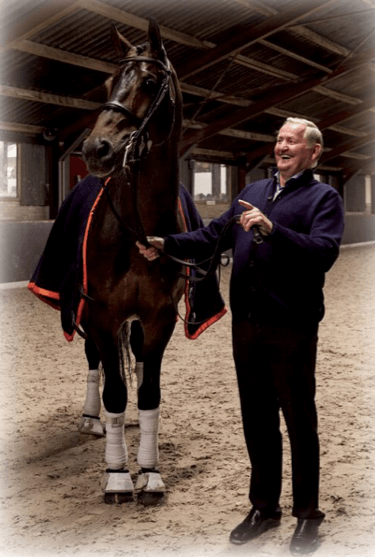
Mr van Norel died in 2021 but his stud continues to be one of the most influential in The Netherlands, run by his sons. I was lucky when my friend, Johan Hamminga, arranged an interview with one of them, Martin van Norel.
Are you still using the original mare lines that your father established?
“Yes. We have a number of mare lines, my father did not like to have one mare line only. It’s not always the same mare line that gets the best one every year. Of course, there are some mare lines that come back, and you say, there is that same strong line. We have the Zelma line, and every time it comes back.”
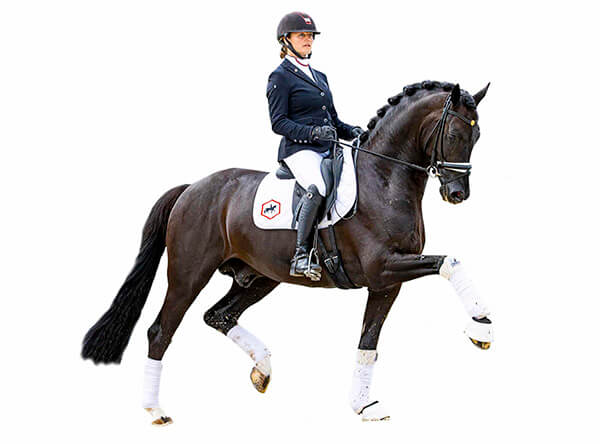
Hexagon’s Kaygo
Rocky Norel is by Hexagon’s Kaygo, a small tour competitor with Thamar Zweistra. He is by Capri Sonne Jr, a serious Grand Prix horse for British rider, Laura Tomlinson. Capri Sonne is by the Ferro son, Rhodium out of a mare by the jumping Holsteiner, Ramiro. Capri Sonne’s dam Wendela reminds us of the influential role of German blood in Dutch dressage breeding, she is by the excellent Hanoverian stallion, Wolkentanz, out of a Dutch bred mare by the Nimmerdor son, Glendale, whose main claim to fame is that he is the dam sire of Totilas. But it is on Rocky’s dam line that history shines…
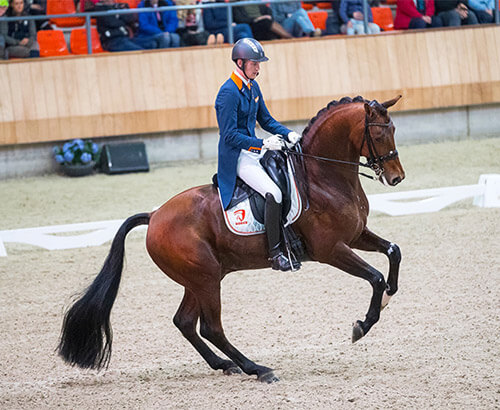
Expression: Digishots image
Rocky’s dam, Kiekiezelma is by Expression, the current star of the Pretendenthoeve stallion band. Expression is by Vivaldi, out of Melody by Vincent by Prentendent, the first KWPN stallion bred by Mr van Norel, and the horse that gave the stud its name. Back to the mare line, Kiekiezelema is out of Eriezelma out of Ruzelma out of Liezelma, out of Duzelma, out of Vuzelma, out of Pluzelma, out of… ZELMA!
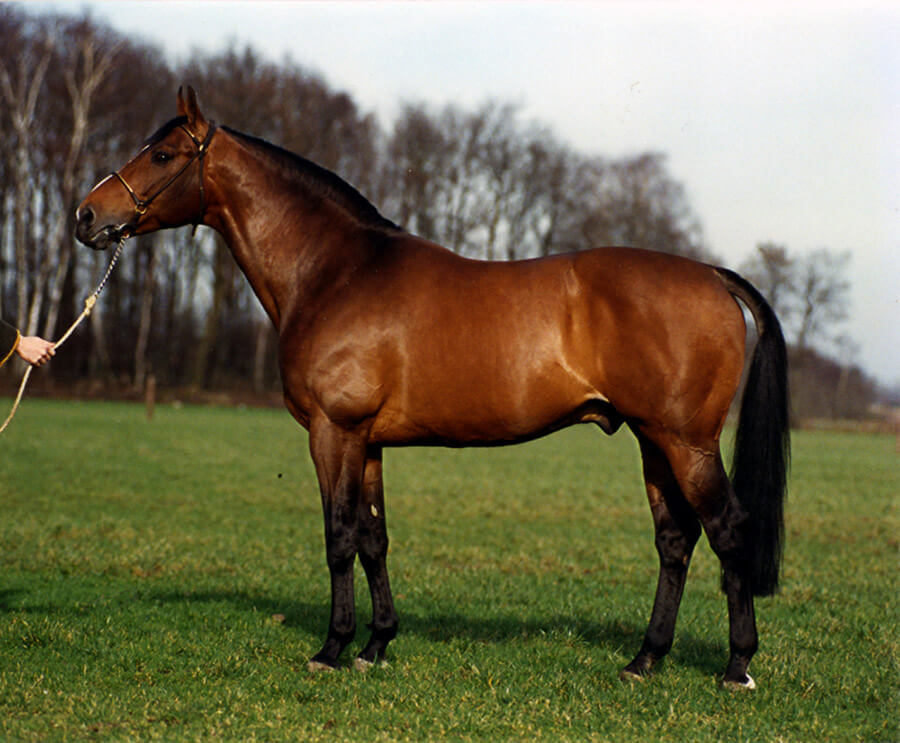
Pretendent (Le Faquin xx/Duc de Normandie SF), the stallion that gave the stud its name
Pluzelma is branded KWPN, while Zelma is termed Sgldt or Gelderlander, harking back to the original agricultural horse. Back in 1992 in his book The Leading Stallions of The Netherlands, Dutch journalist and photographer, Jacob Melissen, observed of the Dutch sporthorse: “Its roots lie in the past, developed by farmers who bred horses because they needed them. They recognized the value of essential characteristics. Experience had not only taught them the great value of powerful hind quarters and a deep chest giving plenty of space for heart and lungs, but they also attached great importance to character, such as work attitude, maximum usability and the willingness to give that last little bit. Horses that did not possess such qualities were simply not used for breeding purposes.”
These agricultural horses were shaped by the challenges they faced. For the sandy soil in the middle of Holland, a lighter type emerged, the Gelderlander, while to the north, on Friesian clay, the Groninger prevailed. As horses were phased out of agriculture, horse breeders turned to a new and rapidly growing market for the sport horse, so much so, that by the time breeding administration was taken over by what was to become the KWPN, those original horses were in danger of disappearing. Again, Jacob takes up the story:
“Originally the KWPN only recognized two categories of horses: the riding and sport horse, and the driving-horse. But there was a persistent group of admirers of the authentic farmer’s horse which had, in fact, laid the basis for both categories. And when the time came that the real farmer’s horse in its original form had virtually become extinct, and no more than a few stallions and a handful of mares remained, these loyal patrons asked to be allowed to try and preserve this basic breed…”
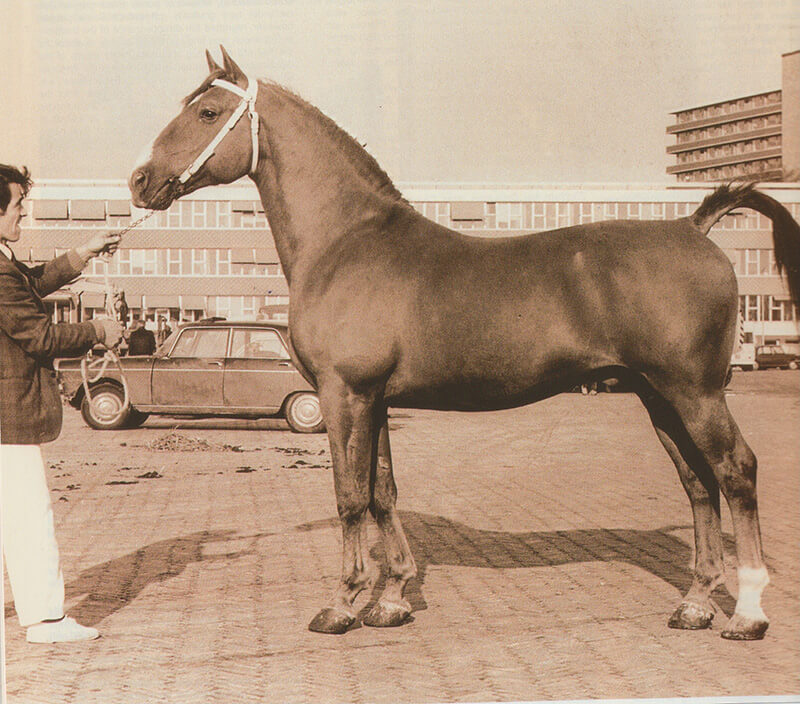
Commandant – of this stallion Jacob Melissen writes: ‘Commandant has become a symbol of the struggle to preserve the basis horse. Without him there would be nothing left of the once glorious Gelderland breed.’
Which is why, every year at the great stallion show in Den Bosch, along with the dressage and jumping rings that are the overwhelming focus of attention, there is a separate selection process for driving horses, and one for the Gelderlanders.
Zelma is by the Gelderlander stallion, Odin van Wittenstein, a son of the Selle Français stallion L’Invasion, which reminds us that those early Dutch breeders turned first to France in search of jumping blood, before the focus shifted to Holstein.

Odin van Wittenstein
Back to Pretendant, who sired the KWPN approved stallions Vanitas and Vincent, both of whom successfully competed in Small Tour and Grand Prix dressage under Annemarie Sanders-Keijzer.

Vincent
Vanitas is the sire of Duzelma who bred to the Vincent son, Cabochon, foaled Hiezlema, who when covered by Bert Rutten’s Grand Prix competitor, Havidoff, a son of another of Bert Rutten’s Grand Prix rides, Clavicimbel, produced Liezelma.

Havidoff
Then we come to another of the threads that make up the modern Dutch dressage horse, the blood from over the border in Germany, Liezelma bred to the Westfalien Darlington, produced Ruzelma, who when bred to another of the stallions that put Pretendenthoeve on the map, Uphill (Oscar / Apollonius xx) foaled Eriezelma who attentive readers will remember is the grand-dam of Rocky Norel.
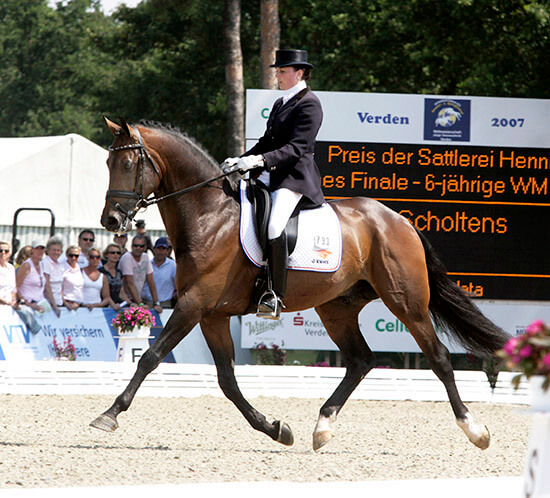
Uphill – image Jacob Melissen
Back to Martin:
“Those lines keep coming back because they are strong on the fundament, they are strong on the movement, good characters, those lines produce every time a good horse.”
Where did your father go looking for mares ? Because at that stage no-one was breeding for dressage…
“My father was the first one in Holland who specialised on dressage. Not on purpose, it was because we had Pretendent approved, he was a super mover, so we were forced into the corner of dressage. My father was ahead of the crowd and we became known for having horses with movement. Pretendent could jump really well, but we never tried him at the highest level because we were now into the dressage. His offspring were super moving and the dressage riders were looking for them. Johan knows all about it, he was following us from the start.”
It was time for Johan Hamminga, one of the most acute observers of the Dutch breeding scene, to join the conversation…
“As I told you, he was the first and the only one breeding dressage. When you have a very good mare, then she produces every five foals, a really excellent foal, then you have a really good breeding mare. It’s not every year a top foal, that’s impossible, but from five foals you have one or two excellent foals, then you have a top mare and that’s what they had with Zelma.”
Martin, your father used to work with the mares in the fields?
“That’s how he got to know the mares, he learnt if they had the character to go through when it was difficult. They have to stay strong and healthy. If the horse was lame, you got rid of it, that’s why the Gelderlander horses were such strong horses. There were some farmers, like my grand-father, who every now and then when they had a top top mare, would save her for breeding, but he could do that only with one mare, not with all the mares because they had to do the work on the farm. That was the old tradition of selecting horses, and that is nowadays still in some of the mare lines in Holland, they were severely selected by the farmers in the old days.”
But nowadays some are breeding to stallions that have not even done a performance test, like Dynamic Dream…
“I was discussing it yesterday with Johan, if you look to the horses that end up Grand Prix, like Hitmaker, he is less used now that he is a Grand Prix stallion than when he was a younger horse. That is amazing for me, stupid!”
Fashion breeding not real breeding…
“But it is typical for dressage, the jumping breeders are the other way around, they breed to the horses that go 1.60m or higher in jumping, and the stallion owners complain they cannot get mares to the younger horses. It’s a totally different world from dressage, and I wonder why, because we all want a good sporthorse. Not all Grand Prix stallions are good breeding horses, that is something for me for sure, but if they are also proving they are breeding good offspring, and doing the Grand Prix job, then they should be used, but they are not.”
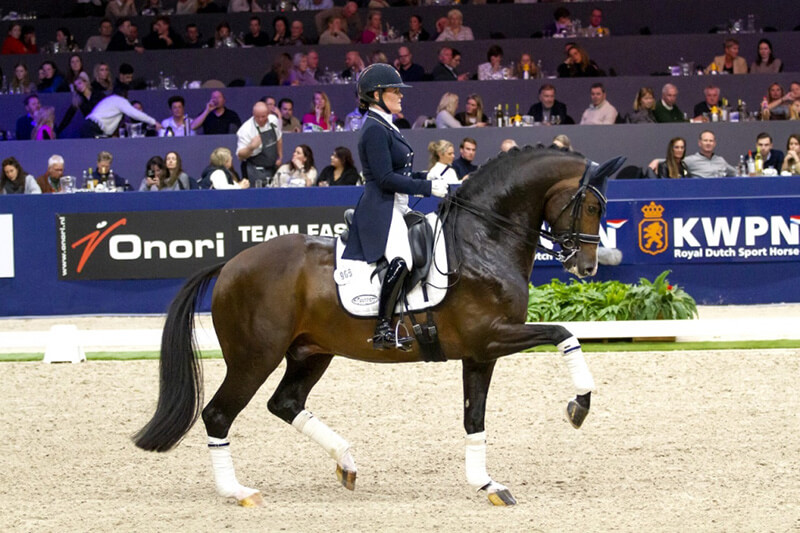
Hitmaker and Jennifer Sékreve
Hitmaker who placed third in the Grand Prix at Falsterbo in July 2024, and who is already the sire of three approved sons, is very much a product of the van Norel program. He is by the Grand Prix competitor, Wynton (by Jazz out of a mare by dressage superstar, Matador) but his mare line is rich in the names that have made Pretendenthoeve famous, his dam Maduna is by Cabochon by Vincent by Pretendent.
Many of the fashionable young stallions today are withdrawn from competition because they are suddenly ‘injured’, is that going to create a problem?
“That’s the question. We will see in 20… 30 years time if the horses are not so strong. I believe so, but on the other hand, there are two sides to this, it is not only that the horses are not that strong any more, but nowadays the ask in dressage is that much greater, the piaffe is that much higher, once when the toes were off the floor it was okay, now they have to be at least ten centimetres, so the job for the horses is much more severe at the higher level, and more elasticity is asked for. That needs another type of horse, much more elastic.”
The mares you presented yesterday at the show were all very modern, elegant…
“My father taught us that, we were lovers of Thoroughbred in our pedigrees. We like this modern type of horse with a lot of elegance.”
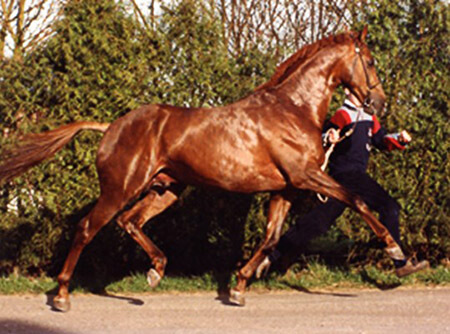
Apollonius
Time for Johan; “They used the stallion, Apollonius, and now Apollonius is in the third or fourth generation, and a Thoroughbred in the third or fourth generation gives a lot of elegance and canter and suppleness, and also temperament, there’s a finish line they’ve got to go through.”
Apollonius xx (Lombard / Gulf Pearl) is the product of one of Germany’s most historic and successful Thoroughbred studs, Gestüt Schlenderhan, founded in 1869 and still a force in racing today.
Sure enough Apollonius makes two appearances on Rocky Norel’s pedigree, grand-dam sire of Expression, and dam sire of Uphill.
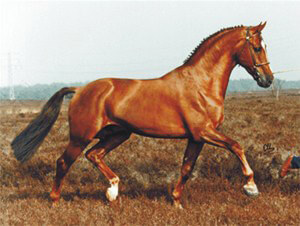
Cabochon
I asked Martin, what have been the most important recent stallions you have used…
“I can name two now, the best known was Uphill and also Cabochon, he gave us super horses. It is a pity that we were not able to have a son of his approved. Cabochon gave super temperament, super hard horses, and also excellent horses for amateurs, but also for professional riders, and that’s something you seldom see in a stallion, from the recreational riders to professional Olympic horses – we had one at the Rio Games by Cabochon, Egistar, out of a Kaiserstern xx mare, also Thoroughbred, that worked really well, and that was our goal also with Apollonius.”

Egistar and Kiichi Harada, winning in Florida (photo – Kenneth Braddick)
How many mares are you breeding with now?
“So far this year, we have twenty one mares in foal.
Are you breeding to outside stallions like Vivaldi?
“Yes, sometimes we need other blood. We have a lot of Vincent, Cabochon, Oscar, in our breeding, with Vivaldi, we got Expression, he is out of one of our mares, Vincent and Apollonius xx.”
“Now it is harder for us as stallion owners, in the old days with no open borders, no Helgstrand, people came to local stallions, now they are buying semen from abroad when they used to come to our stud, it makes our job much more difficult with frozen semen, and the fresh semen that is available in Holland. The dressage world is a small world, only Western Europe, a little bit America.”
Which of your younger stallions do you think will be important in the next five, ten, years?

Rocky Norel
“I really like this young Kaygo stallion, Rocky Norel, Johan approved him last winter and I think he can do some really good work for us. Next year the first crop will come, then we will see which side it is going to, is it going to the dam side a little, or is it going to the father’s side. Then we will know a little more about what combinations you should use with him. In the past that’s how it was with Jazz, the first few years of Jazz, or you could also say Vivaldi, was not that successful. It was only successful after a few years when the breeders knew which mares to use. It was the same with Negro, what mares to use with Negro for a bit more modern type.”
“You have to find out first how the first crop is, then you can go a little this way, or that way, searching for your best mare for this combination, and that takes time. That’s the life of a breeder, my father always said to us, my life is too short to bring what is in my mind. My father always had an idea of which way he wanted to go with the breeding, and that is something I miss a bit nowadays with the breeders, and sometimes a bit with the studbook, to have an idea which way we should go with the breeding. These are the kind of horses we need for the future, and we want to go that way. Now the breeders are more, how can I sell the foal next year, that’s not a goal, a short term goal, not a long term goal. That is what I miss a bit in today’s breeding.”
“Of course I know that a lot of breeders cannot keep a foal for a long time, they have to sell for financial reasons. For us, my father always taught us quality was most important, over the fancy names. That is not the most important thing, the fancy names, how good is the horse – that’s the important thing. If the horse is super with no fancy names, I’d rather have that than fancy names with no quality.”
Both Martin and Johan were concerned with what they saw as the tendency in younger riders:
“The young riders don’t have the skills of the riders of Johan’s generation, his generation were trained, they had more skills to cope with all kinds of horses. Nowadays, the young riders don’t have this skill any more. There are some riders who have the skill, but they are getting less and less. What we miss in Holland in my opinion, is a school for riders, the basics are not there anymore. There is no school to turn those young riders into a good rider who can manage the horse. That is something we will miss in Holland in the near future.”
Johan: “A couple of years ago, there was on every corner a guy who could break in a horse. The breeder could say, can you break in my horse, and in one month or six weeks, he would be riding the horse. Now in Holland there are five or ten riders who can break in a horse, we have to get riders from places like Poland.”
“Our young riders are afraid, and when you put them on a horse, it is terrible what they do, when you are afraid you hang on the reins, and become stiff, it doesn’t work. When you have a good rider break in a horse, he is supple and says okay, go forward. Then for the horse it is very easy, he goes in trot or in canter, no problem, but when you keep hanging on the reins because you are afraid, it gets worse and worse.”
I wanted to know, what kept Martin van Norel and his family involved in the horse business…
What drives you, what makes you passionate about breeding?
“To see what is next. To make combinations of mares and stallions, that you hope you do a good job in the future. What keeps us going is good stories from the market, I know in America there are a lot of people riding horses by Expression, they really like the Expression offspring there, he has a real fan club.”
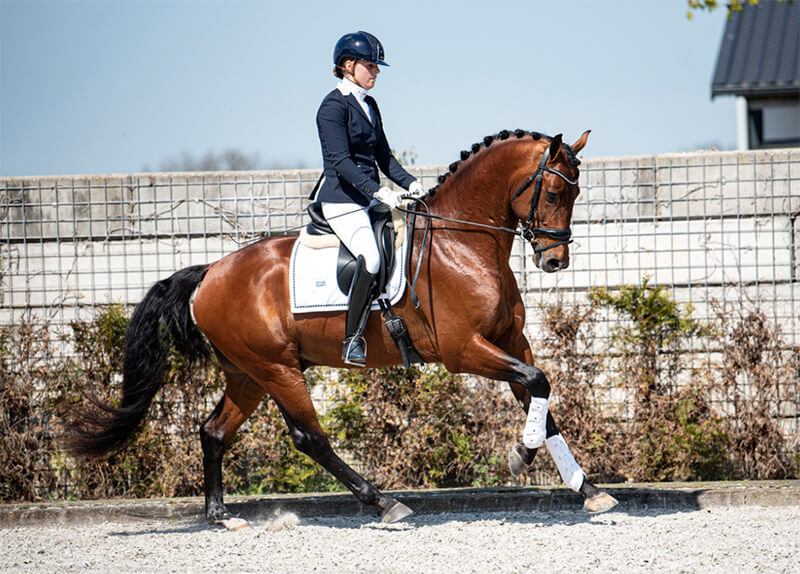
Mr Magnum, by Expression
Johan again: “It’s the canter, the canter for the offspring of Vivaldi, especially from Expression, is very good and they have a very high level of rideability. For the future that is more important, the younger riders do not want to spend so much time, so we need to breed a horse that learns his exercises very easily and very quickly. Horses that do the work very quickly and in harmony, longer in the neck, light in the contact and very supple. That is the direction for the new generation.”
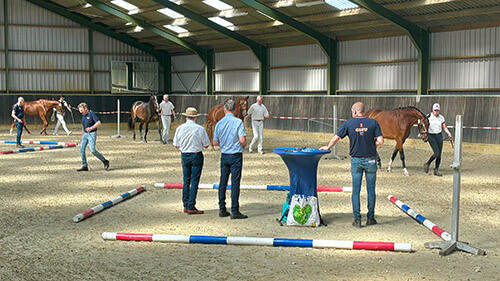
Martin summed it up: “
That was always our goal, so it is nothing new for us. But what I said before about the piaffe being higher and higher, I think that time has passed, because then you get the tail that goes around like a propeller. That’s not nice to look at for the audience and also the judges. For the future, it must look like it is natural. For that you need horses that want to go forward, that want to work, so you don’t have to push them, that’s the future. It’s nothing new for us, my father always tried to have stallions that gave this and horses that have these qualities.”
